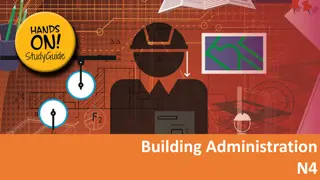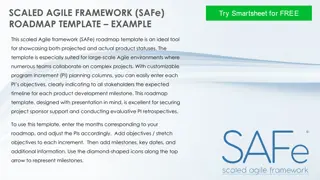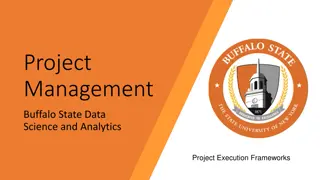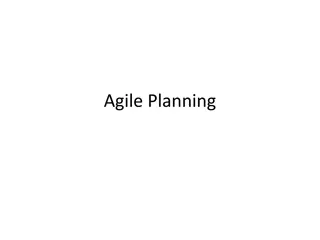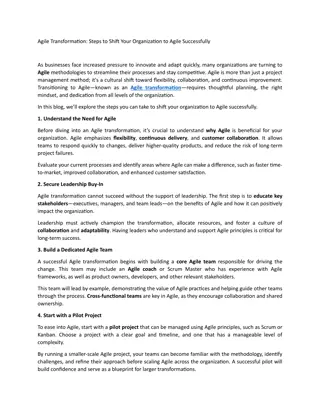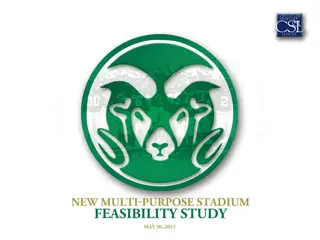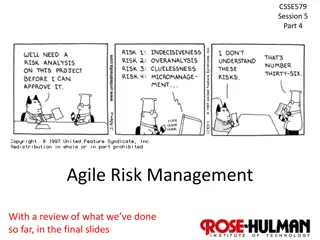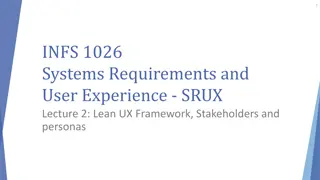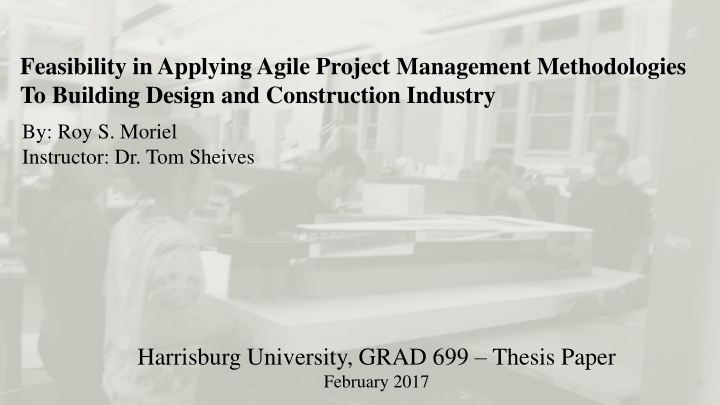
Feasibility of Agile Project Management in Construction Industry
Agile methodology holds promise for enhancing project efficiency in the building design and construction sector. Challenges and proposed solutions are examined through a literature review, shedding light on the feasibility of adopting Agile practices in this industry.
Download Presentation

Please find below an Image/Link to download the presentation.
The content on the website is provided AS IS for your information and personal use only. It may not be sold, licensed, or shared on other websites without obtaining consent from the author. If you encounter any issues during the download, it is possible that the publisher has removed the file from their server.
You are allowed to download the files provided on this website for personal or commercial use, subject to the condition that they are used lawfully. All files are the property of their respective owners.
The content on the website is provided AS IS for your information and personal use only. It may not be sold, licensed, or shared on other websites without obtaining consent from the author.
E N D
Presentation Transcript
Feasibility in Applying Agile Project Management Methodologies To Building Design and Construction Industry By: Roy S. Moriel Instructor: Dr. Tom Sheives Harrisburg University, GRAD 699 Thesis Paper February 2017
Problem Statement Agile methodology development in other industries such as IT - Adaptation to quick technological enhancements - Respond to rapidly changing environments - Develop and improve project features through trial and error iteration cycles Building design and construction industry and the traditional method - Process inefficiencies - Cost impact - Schedule impacts Investigate how to adopt Agile methodology in the building design and construction industry - Challenges of adopting Agile - How to incorporate it in the building design and construction industry Feasibility in Applying Agile Project Management MethodologiesTo Building Design and Construction Industry
Literature Review I Agile Method Implementation by Sabah Nouri and Mohammed Hossain (2012) - Six Challenges Involving Agile adoption and Replacing the Traditional Method 1. Agile and industry standards conflict 2. Business process differences within the project 3. The individual s characteristics and traits 4. Communication procedures differences 5. Client involvement 6. Company cultural adaptation Feasibility in Applying Agile Project Management MethodologiesTo Building Design and Construction Industry
Literature Review I Agile Method Implementation by Sabah Nouri and Mohammed Hossain (2012) Proposed solutions for challenges above 1. Prototype team that will experiment, practice, and formulate processes to deal with changes 2. Training program to cope with new processes 3. Unique hiring process for highly adaptive, flexible, and communicative team members 4. Keep elements from traditional project methodology. Hybrid possibility 5. Not a problem in the architectural world, client involvement at high levels typically due to intimate nature of architect/ client relationship 6. Multi phased transition, starting from small scale before company transformation Feasibility in Applying Agile Project Management MethodologiesTo Building Design and Construction Industry
Literature Review II A Systematic Literature Review on Agile Project Management by Sumsunnahar Sheyly (2013) - Advantageous attributes following Agile adoption and Replacing the Traditional Method and potential hardships: 1. Enhancement of communication 2. Self management and efficiency in progression of project processes (hierarchy eliminated) 3. Schedule based on many cycles more iterations, better final product 4. Project structure different results with better creative environment 5. Better fit for innovative conditions, changing conditions 6. Company cultural adaptation Not challenges but requirements that can help Agile Adoption Feasibility in Applying Agile Project Management MethodologiesTo Building Design and Construction Industry
Methodology The process for relating Agile adoption to the building design and construction industry - Compare existing methods 1. Pinpoint the flaws in current architectural process with relation to the traditional method (administration of the building design process) 2. Analyze what needs to change, and understanding the problematic parameters in the traditional setting - Propose Agile methodology alternatives within the building design process 1. Reviewing Agile methodologies: Scrum, Kanban, - Summary of findings and propose and recommendation of future work 1. How can Agile fit into the traditional project characteristics 2. Creation of a Hybrid Agile Traditional methodology to encounter current inefficiencies. . Feasibility in Applying Agile Project Management MethodologiesTo Building Design and Construction Industry
Findings Comparing existing methods . Feasibility in Applying Agile Project Management MethodologiesTo Building Design and Construction Industry
Findings Comparing existing methods Current Design Process Critique - Architectural process in the building design and construction industry in its pure traditional form. -No need for Agile adoption during programming, schematic design phases. Minimal interaction required for project progression. - Design development, construction documents, construction administration phases are inefficient due to communication and work overload intensities. - Agile methodology study should be made to see how these phases could be improved. - Specific agile techniques will be investigated to create a hybrid. Feasibility in Applying Agile Project Management MethodologiesTo Building Design and Construction Industry
Findings Comparing existing methods . Feasibility in Applying Agile Project Management MethodologiesTo Building Design and Construction Industry
Findings Comparing existing methods Current Design Process Critique - Each phase can consist with hundreds of tasks required to be completed. - Current Process task requires dozens of interaction actions - Time required for task completion is extended to inefficiencies -Too many people involved in an inefficient team structure and composition. - New ways are required to execute tasks. . Feasibility in Applying Agile Project Management MethodologiesTo Building Design and Construction Industry
Discussion and Recommendation Hybrid Prototype Elements within the traditional methodology must remain - Ultimate goal will not change (building as product) and is a known factor - Delivery time and phases developed in industry will remain as standards -Programming phases in the beginning of building design and construction project will remain as it establishes the building parameters and client relationship necessary to push the project ahead. - This is crucial to solve the questions and problems laid out, and transform these requirements into spatial forms and different program relationships. Feasibility in Applying Agile Project Management MethodologiesTo Building Design and Construction Industry
Discussion and Recommendation Hybrid Prototype Agile Project Methodology - Technological advances and new manufacturing processes required to project management system (not end result based) - Nonlinear dynamic processes, with trial and error -Quick iterations for more development attempts, creating a better more refined product - Improvement in project team culture: communication, team knowledge, better quality, better adaptation to changing requirements and elements. Feasibility in Applying Agile Project Management MethodologiesTo Building Design and Construction Industry
Discussion and Recommendation Hybrid Prototype Scrum -Base of swift iteration cycles containing a process of trial and error - Efficient to improve communication processes where they are slow and inefficient -Agile Scrum as ideal fit for the building design and construction projects -Mechanism to transform team structure and coordination processes --Ability to adapt to changing requirement (fewer change orders) Feasibility in Applying Agile Project Management MethodologiesTo Building Design and Construction Industry
Discussion and Recommendation Hybrid Prototype Scrum framework - Product backlog - Sprint planning - Sprint execution - Daily Scrum - Sprint review meeting - Sprint retrospective Feasibility in Applying Agile Project Management MethodologiesTo Building Design and Construction Industry
Discussion and Recommendation Hybrid Prototype Scrum stakeholders - Product owner - Scrum master --Scrum team Feasibility in Applying Agile Project Management MethodologiesTo Building Design and Construction Industry .
Discussion and Recommendation Hybrid Prototype Scrum and the Building Design Process Current team optimization required Structure change: Architects + main core engineers together in same team Consultants as temporarily team stakeholders when needed Contractor/client coordination effort is simplified through single team or the product owner Feasibility in Applying Agile Project Management MethodologiesTo Building Design and Construction Industry
Discussion and Recommendation Hybrid Prototype Hybrid Scrum for A+E Feasibility in Applying Agile Project Management MethodologiesTo Building Design and Construction Industry
Discussion and Recommendation Hybrid Prototype Hybrid Scrum for A+E Feasibility in Applying Agile Project Management MethodologiesTo Building Design and Construction Industry
Discussion and Recommendation Hybrid Prototype Kanban Addition to the Scrum Framework Project information management efficiency Visualization of workflow using Kanban boards Better understanding of project events through summarizing Scrum activities within the board as well. Higher team participation and Project changes awareness Carmichael, A. Anderson, D. (2016). Kanban Board Example - Visualizing the Workflow Feasibility in Applying Agile Project Management MethodologiesTo Building Design and Construction Industry
Conclusion Traditional waterfall method fails to adapt to communication and coordination intensities found in contemporary large projects Many industries today incorporated Agile, the building design and construction projects should follow the same. Problems identified in existing project execution and relevant elements Hybrid Scrum for A+E formulized to enhance project efficiency and provide layout for further research and development. Feasibility in Applying Agile Project Management MethodologiesTo Building Design and Construction Industry

